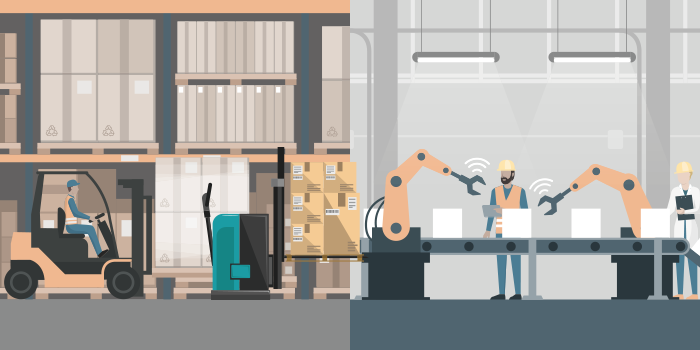Production companies are currently developing in leaps and bounds:
- Automation is becoming more and more widespread and is taking on the characteristics of a snowball effect.
- The networking of internal and external players is becoming ever closer, so that work processes are increasingly merging with one another.
- The trend towards individualisation of products, even in series production (“mass customisation”), is leading to decreasing batch sizes. As a result, production processes are becoming increasingly complex.
As a result of these developments, the requirements of production for production logistics are also changing significantly. Among other things, this affects the choice of location for production logistics, the set-up process, the synchronisation of production and logistics and IT systems.
The location as a central factor for the internal delivery service
Just-in-time or just-in-sequence delivery is usually the ideal case from a production perspective. In reality, however, materials are usually provided within hours rather than minutes. In order to be able to provide a short-cycle service, the physical proximity of production and logistics is of crucial importance. To achieve this proximity, companies usually choose one of the following strategic options:
- Spatial consolidation of production and production logistics.
- Setting up (automatic) buffers in production if the distance between production and the supply warehouse cannot or should not be reduced.
Rising set-up costs increase transport and labour requirements as well as throughput times
The decreasing batch sizes in production mean that processing in both production and logistics is becoming increasingly compartmentalised. Frequent set-up increases the frequency of internal transport, labour costs rise and the interdependence of work areas increases. Companies are countering these developments with various concepts.
The most frequently used measures include
- the automation of processing at critical points, particularly in internal transport, for example using AGVs, and
- the creation of additional buffer areas between individual production operations with spatial separation of production and logistics.
Merging processes need functioning synchronisation and reliable emergency scenarios
The synchronisation of processes is no longer limited to production. The increasing automation of logistics is also becoming a driver of complexity in overall processing. In this way, dependency on each other is increasing, especially when production and logistics are in close proximity.
To minimise the impact of problems in logistics on the production process, it is necessary to carefully coordinate the processes. The aim should be to provide sufficient temporal and spatial buffers. Experience has shown that the best way to develop such synchronisation processes is for logistics and production to work out an appropriate concept together. In this way, it can be ensured that the different requirements are equally taken into account.
Fine-grained control requires high transparency
In order to be able to act quickly and flexibly in production control, data acquisition at the level of the individual process steps and an intensive exchange of data between production and logistics are becoming increasingly necessary. These are the prerequisites for
- minimise production interruptions due to missing parts,
- deploy personnel as required,
- provide material replenishment on time.
This is why many companies are focussing on more intensive but now simplified data collection, especially using mobile data collection devices such as wearables or touch panels. In addition to constant communication with production, the data collected also makes a significant contribution to improving logistics processes.
In addition to synchronisation, it is also important to define reliable emergency scenarios. Although manual interventions and follow-up processes do not offer a complete replacement, they can often enable basic production capability.
Conclusion: Long-term change process requires coordination and flexibility
The current and expected changes in production place new demands on logistics. A long-term adjustment process can be assumed in which the performance of production logistics is regularly scrutinised. Many companies can significantly improve their processes in the course of this by promoting co-operation between production and logistics and close coordination at eye level. It is also advisable to focus on development concepts that enable technical, organisational and economic flexibility. In this way, companies can maintain their adaptability and react more easily to changes.


